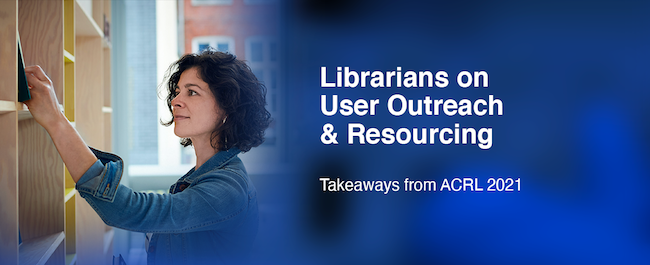What are the most successful ways librarians have interacted with faculty and students during the pandemic? What are some new channels they used for outreach, and how do they evaluate new resources?
As the long-term need for virtual library services and digital resources becomes increasingly clear, these questions have become especially pertinent. This year, at the ACRL (Association of College & Research Libraries) Virtual Conference 2021, we had the pleasure of speaking with librarians and attending virtual librarian-led sessions to learn more about their challenges and successes in supporting STEM students and faculty.
We also conducted a survey with 41 participants about their experiences of librarian resourcing and outreach in STEM. The respondents identified as working at doctoral universities, master’s colleges or universities, baccalaureate colleges, as well as other academic institutions. Their titles included, among others, liaison librarian (47%), reference librarian (36%), and subject librarian (22%).
Here, we outline some key takeaways from the ACRL 2021 conference, including the results of our survey and insights from various presentations.
Outreach during the Pandemic: Meetings & Consultations
According to our survey, 1-on-1 meetings and consultations were some of the most effective methods of interacting with faculty during the pandemic, with over 66% of respondents rating them extremely or very successful. Several librarians reported using Zoom as their tool of choice — unsurprisingly.
62% of respondents also indicated that consultations were very or extremely successful for interacting with students, whereas for many, library events such as lecture series saw a relatively poor turnout. “Our usual modes of outreach fared better when simply translating instruction & reference online,” noted one respondent.
How can one effectively translate in-person consultations into virtual formats? In their session Connection in a Time of Isolation: Designing Human Online Services for Students, librarians at Grand Valley State University, Jennifer Torreano (Knowledge Market Manager), Melanie Rabine-Johnson (Digital Student Experience Specialist) and Maya Hobscheid (Instructional Design Librarian), discuss their key takeaways from their experience of creating a virtual version of their collaborative peer consulting service.
For them, 5 key points to consider are: the core values that support the service, its mission, its essential qualities, Universal Design for Learning principles, and a framework for assessing the service. Consideration of these helped guide the creation of their digital service — they designed a platform that would be able to replicate the ethos of their in-person service, even if it could not embody its physical aspects.
Outreach during the Pandemic: Library Classes
Library classes for students were by far the most successful means for interacting with students, with 75% of respondents rating these as extremely or very successful. In his presentation Maximizing Zoom in Virtual Library Instruction and its Impact on Active Learning, Jonathan Cornforth, Student Success Librarian and Reference & Instruction Librarian at California State University Fullerton, explained how a library instruction class was made more engaging by dividing it into two sessions, focused on a demonstration and group-based activities respectively (both over Zoom, with the use of breakout rooms for the latter). Student progress in the second session was monitored by assigning tasks such as locating an article and emailing it to the instructor, and students were encouraged to add sources they discovered to a shared database for the course. This helped boost engagement, Cornforth notes.
Interestingly, library classes for students also appeared to provide a helpful channel for interaction with faculty. In her virtual session COVID-19 - Lessons from the Pandemic on How to Conduct Outreach and Engagement Online, Jennifer Joe, Undergraduate Engagement Librarian at the University of Toledo, explained how informing a program director about a library session for students served as a valuable pipeline to faculty within the program. This particular session, an ‘Ask-Me-Anything’ session where attendees could come with any and all questions, was also one of her most successful student outreach events.
When planning such sessions, Joe also notes, timing them in accordance with student needs is key. For instance, the ask-me-anything session was scheduled shortly after students received their mid-term grades; students who wanted to improve or maintain their grades, Joe suggests, might have been more motivated to attend as a result.
Resource Evaluation
What are the most important factors considered by librarians when evaluating resources for their STEM users? 87% of respondents indicated that “increased student success in STEM classes” was very or extremely important, followed by the presence of an active learning activity of tool (61%). Nearly 90% of respondents indicated that the input of faculty was an important factor while considering library materials to purchase for STEM users, followed by the input of department heads.
The presentation Gone, but not forgotten: an assessment framework for collection reviews, Kristin Calvert (Head of Discovery & Technology Services) and Whitney Jordan (Acquisitions Librarian) at Hunter Library, Western Carolina University provides further insights into factors considered by librarians while reviewing resources. According to their survey of liaison librarians and those involved in collection review decisions, important factors included usability and interface, uniqueness of content and faculty feedback, among other criteria.
Meeting Outreach and Resource Needs with JoVE
JoVE proudly sits at the center of libraries, scientific research and STEM classrooms. With a library of 13,000+ video resources for science research and education across a wide variety of disciplines, JoVE has been demonstrated to improve student learning outcomes in STEM courses, improve productivity and reproducibility in the lab, and help faculty save lesson planning time.
Yet, JoVE doesn’t just create high-quality STEM videos—we also provide a seamless integration process for libraries, faculty and researchers. We’ve created a dedicated librarian resource center to support user outreach, along with integration and set-up guides. JoVE Curriculum Specialists can create customized playlists mapped to syllabi or research programs and offer comprehensive technical support, making it easy to embed videos into Learning Management Systems (be it Blackboard, Moodle, Canvas, or others). JoVE videos also come with quizzes to enable interactive learning for students!
Want to learn more about how JoVE can support your institution? Get in touch here.

